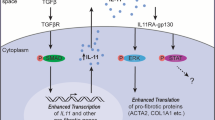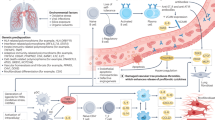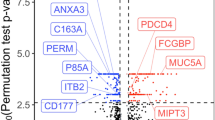Abstract
Scleroderma interstitial lung disease (SLD) is a leading cause of morbidity and mortality in patients with systemic sclerosis. Although the pathogenesis of SLD is not clear, excessive fibrosis and inflammatory cell infiltration are the main histologic features of this disorder. Leukotrienes and lipoxins are two functionally different classes of lipoxygenase-derived eicosanoids. Leukotrienes are potent proinflammatory mediators and directly and indirectly stimulate fibroblast chemotaxis, proliferation, and collagen synthesis. Lipoxins counter-regulate the proinflammatory actions of leukotrienes and activate resolution of the inflammatory response. In addition, lipoxins inhibit growth-factor-induced fibroblast proliferation and collagen synthesis. Studies using bronchoalveolar lavage have revealed that there is an overproduction of proinflammatory and profibrotic leukotrienes in the lungs of patients with SLD, and that leukotriene levels correlate with inflammatory indices within the lungs. Moreover, the increased levels of leukotrienes in these patients are not balanced by an upregulation of anti-inflammatory and antifibrotic lipoxins. Unopposed actions of leukotrienes might, therefore, induce chronic inflammation and fibrosis in the lungs of SLD patients. Accordingly, pharmacologic correction of a leukotriene–lipoxin imbalance using leukotriene inhibitors or lipoxin analogs might be a new approach to the treatment of SLD.
Key Points
-
Fibrosis and chronic inflammation are main histologic features of scleroderma interstitial lung disease (SLD), which is a leading cause of morbidity and mortality in patients with systemic sclerosis
-
Increased levels of proinflammatory and profibrotic leukotrienes are found in the lungs of patients with SLD
-
The levels of leukotrienes correlate with lower-respiratory-tract inflammation as estimated by cytologic analysis of bronchoalveolar lavage fluid
-
There is a relative deficiency of anti-inflammatory and antifibrotic lipoxins in the lungs of patients with SLD
-
Correction of the leukotriene–lipoxin imbalance might be a promising new approach for the treatment of patients with SLD
This is a preview of subscription content, access via your institution
Access options
Subscribe to this journal
Receive 12 print issues and online access
$209.00 per year
only $17.42 per issue
Buy this article
- Purchase on Springer Link
- Instant access to full article PDF
Prices may be subject to local taxes which are calculated during checkout



Similar content being viewed by others
References
White B (2003) Interstitial lung disease in scleroderma. Rheum Dis Clin North Am 29: 371–390
Thannickal VJ et al. (2004) Mechanisms of pulmonary fibrosis. Annu Rev Med 55: 395–417
Samuelsson B et al. (1987) Leukotrienes and lipoxins: structures, biosynthesis, and biological effects. Science 237: 1171–1176
Henderson WR (1994) The role of leukotrienes in inflammation. Ann Intern Med 121: 684–697
Serhan CN (2005) Lipoxins and aspirin-triggered 15-epi-lipoxins are the first lipid mediators of endogenous anti-inflammation and resolution. Prostaglandins Leukot Essent Fatty Acids 73: 141–162
Koyama S et al. (1998) Human lung fibroblasts release chemokinetic activity for monocytes constitutively. Am J Physiol 275: L223–L230
Palmantier R et al. (1991) Thrombin-activated platelets promote leukotriene B4 synthesis in polymorphonuclear leucocytes stimulated by physiological agonists. Br J Pharmacol 103: 1909–1916
Fiore S et al. (1990) Formation of lipoxins and leukotrienes during receptor-mediated interactions of human platelets and recombinant human granulocyte/macrophage colony-stimulating factor-primed neutrophils. J Exp Med 172: 1451–1457
Schonfeld W et al. (1988) Leukotriene generation and metabolism in isolated human lung macrophages. Immunology 65: 529–536
Levy BD et al. (1993) Human alveolar macrophages have 15-lipoxygenase and generate 15(S)-hydroxy-5,8,11-cis-13-trans-eicosatetraenoic acid and lipoxins. J Clin Invest 92: 1572–1579
Nassar GM et al. (1994) Induction of 15-lipoxygenase by interleukin-13 in human blood monocytes. J Biol Chem 269: 27631–27634
Profita M et al. (2002) Leukotriene B4 production in human mononuclear phagocytes is modulated by interleukin-4-induced 15-lipoxygenase. J Pharmacol Exp Ther 300: 868–875
Levy BD et al. (2001) Lipid mediator class switching during acute inflammation: signals in resolution. Nat Immunol 2: 612–619
Peters-Golden M et al. (2005) Leukotrienes: underappreciated mediators of innate immune responses. J Immunol 174: 589–594
Tager AM et al. (2003) Leukotriene B4 receptor BLT1 mediates early effector T cell recruitment. Nat Immunol 4: 982–990
Prinz I et al. (2005) The type 1 cysteinyl leukotriene receptor triggers calcium influx and chemotaxis in mouse alpha beta- and gamma delta effector T cells. J Immunol 175: 713–719
Brink C et al. (2003) International Union of Pharmacology XXXVII. Nomenclature for leukotriene and lipoxin receptors. Pharmacol Rev 55: 195–227
Gronert K et al. (2001) Selectivity of recombinant human leukotriene D(4), leukotriene B(4), and lipoxin A(4) receptors with aspirin-triggered 15-epi-LXA(4) and regulation of vascular and inflammatory responses. Am J Pathol 158: 3–9
Serhan CN et al. (2003) Reduced inflammation and tissue damage in transgenic rabbits overexpressing 15-lipoxygenase and endogenous anti-inflammatory lipid mediators. J Immunol 171: 6856–6865
Mensing H et al. (1984) Leukotriene B4 induces in vitro fibroblast chemotaxis. J Invest Dermatol 82: 9–12
Baud L et al. (1987) Modulation of fibroblast proliferation by sulfidopeptide leukotrienes: effect of indomethacin. J Immunol 138: 1190–1195
Phan SH et al. (1988) Binding of leukotriene C4 to rat lung fibroblasts and stimulation of collagen synthesis in vitro. Biochemistry 27: 2846–2853
Perng DW et al. (2006) Leukotriene C4 induces TGF-beta1 production in airway epithelium via p38 kinase pathway. Am J Respir Cell Mol Biol 34: 101–107
Peters-Golden M et al. (2002) Protection from pulmonary fibrosis in leukotriene-deficient mice. Am J Respir Crit Care Med 165: 229–235
Beller TC et al. (2004) Cysteinyl leukotriene 1 receptor controls the severity of chronic pulmonary inflammation and fibrosis. Proc Natl Acad Sci USA 101: 3047–3052
Vargaftig BB et al. (2003) Leukotrienes mediate murine bronchopulmonary hyperreactivity, inflammation, and part of mucosal metaplasia and tissue injury induced by recombinant murine interleukin-13. Am J Respir Cell Mol Biol 28: 410–419
Kolodsick JE et al. (2004) Protection from fluorescein isothiocyanate-induced fibrosis in IL-13-deficient, but not IL-4-deficient, mice results from impaired collagen synthesis by fibroblasts. J Immunol 172: 4068–4076
Beller TC et al. (2004) Targeted gene disruption reveals the role of the cysteinyl leukotriene 2 receptor in increased vascular permeability and in bleomycin-induced pulmonary fibrosis in mice. J Biol Chem 279: 46129–46134
McMahon B et al. (2002) Lipoxin, leukotriene, and PDGF receptors cross-talk to regulate mesangial cell proliferation. FASEB J 16: 1817–1819
Sato Y et al. (2004) Down-regulation of lipoxin A4 receptor by thromboxane A2 signaling in RAW246.7 cells in vitro and bleomycin-induced lung fibrosis in vivo. Biomed Pharmacother 58: 381–387
Wu SH et al. (2006) Lipoxin A4 inhibits proliferation of human lung fibroblasts induced by connective tissue growth factor. Am J Respir Cell Mol Biol 34: 65–72
Mitchell D et al. (2004) Lipoxins inhibit Akt/PKB activation and cell cycle progression in human mesangial cells. Am J Pathol 164: 937–946
McMahon B et al. (2000) Lipoxin A4 antagonizes the mitogenic effects of leukotriene D4 in human renal mesangial cells. Differential activation of MAP kinases through distinct receptors. J Biol Chem 275: 27566–27575
Wu SH et al. (2005) Lipoxin A4 inhibits TNF-alpha-induced production of interleukins and proliferation of rat mesangial cells. Kidney Int 68: 35–46
Wu SH et al. (2005) High dose of lipoxin A4 induces apoptosis in rat renal interstitial fibroblasts. Prostaglandins Leukot Essent Fatty Acids 73: 127–137
Rodgers K et al. (2005) Lipoxin A4 modifies platelet-derived growth factor-induced pro-fibrotic gene expression in human renal mesangial cells. Am J Pathol 167: 683–694
Wu SH et al. (2006) Lipoxin A4 inhibits connective tissue growth factor-induced production of chemokines in rat mesangial cells. Kidney Int 69: 248–256
Vachier I et al. (2005) Severe asthma is associated with a loss of LX4, an endogenous anti-inflammatory compound. J Allergy Clin Immunol 115: 55–60
Kowal-Bielecka O et al. (2003) Elevated levels of leukotriene B4 and leukotriene E4 in bronchoalveolar lavage fluid from patients with scleroderma lung disease. Arthritis Rheum 48: 1639–1646
Silver RM et al. (1990) Evaluation and management of scleroderma lung disease using bronchoalveolar lavage. Am J Med 88: 470–476
Wilborn J et al. (1996) Constitutive activation of 5-lipoxygenase in the lungs of patients with idiopathic pulmonary fibrosis. J Clin Invest 97: 1827–1836
Kowal-Bielecka O et al. (2005) Beta thromboglobulin and platelet factor 4 in bronchoalveolar lavage fluid of patients with systemic sclerosis. Ann Rheum Dis 64: 484–486
Witt C et al. (1999) Pulmonary involvement in diffuse cutaneous systemic sclerosis: bronchoalveolar fluid granulocytosis predicts progression of fibrosing alveolitis. Ann Rheum Dis 58: 635–640
White B et al. (2000) Cyclophosphamide is associated with pulmonary function and survival benefit in patients with scleroderma and alveolitis. Ann Intern Med 132: 947–954
Kowal-Bielecka O et al. (2005) Cyclophosphamide reduces neutrophilic alveolitis in patients with scleroderma lung disease: a retrospective analysis of serial bronchoalveolar lavage investigations. Ann Rheum Dis 64: 1343–1346
Goldstein RA et al. (1990) Clinical role of bronchoalveolar lavage in adults with pulmonary disease. Am Rev Respir Dis 142: 481–486
Kowal-Bielecka O et al. (2001) Evidence of 5-lipoxygenase overexpression in the skin of patients with systemic sclerosis: a newly identified pathway to skin inflammation in systemic sclerosis. Arthritis Rheum 44: 1865–1875
Huang L et al. (2004) Leukotriene B4 strongly increases monocyte chemoattractant protein-1 in human monocytes. Arterioscler Thromb Vasc Biol 24: 1783–1788
Ichiyama T et al. (2005) Cysteinyl leukotrienes induce monocyte chemoattractant protein 1 in human monocytes/macrophages. Clin Exp Allergy 35: 1214–1219
Meloni F et al. (2004) BAL cytokine profile in different interstitial lung diseases: a focus on systemic sclerosis. Sarcoidosis Vasc Diffuse Lung Dis 21: 111–118
Distler O et al. (2001) Overexpression of monocyte chemoattractant protein 1 in systemic sclerosis: role of platelet-derived growth factor and effects on monocyte chemotaxis and collagen synthesis. Arthritis Rheum 44: 2665–2678
Distler JH et al. (2006) Monocyte chemoattractant protein 1 released from glycosaminoglycans mediates its profibrotic effects in systemic sclerosis via the release of interleukin-4 from T cells. Arthritis Rheum 54: 214–225
Kowal-Bielecka O et al. (2005) Cyclooxygenase- and lipoxygenase-derived eicosanoids in bronchoalveolar lavage fluid from patients with scleroderma lung disease: an imbalance between proinflammatory and antiinflammatory lipid mediators. Arthritis Rheum 52: 3783–3791
Flaherty KR et al. (2004) Zileuton versus azathioprine/prednisone in idiopathic pulmonary fibrosis. Europ Respir J 24 (Suppl 48): S254
Petasis NA et al. (2005) Design, synthesis and bioactions of novel stable mimetics of lipoxins and aspirin-triggered lipoxins. Prostaglandins Leukot Essent Fatty Acids 73: 301–321
Tager AM et al. (2003) BLT1 and BLT2: the leukotriene B(4) receptors. Prostaglandins Leukot Essent Fatty Acids 69: 123–134
Qiu H et al. (2006) Differential induction of BLT receptor expression on human endothelial cells by lipopolysaccharide, cytokines, and leukotriene B4. Proc Natl Acad Sci USA 103: 6913–6918
Kanaoka Y et al. (2004) Cysteinyl leukotrienes and their receptors: cellular distribution and function in immune and inflammatory responses. J Immunol 173: 1503–1510
Uzonyi B et al. (2006) Cysteinyl leukotriene 2 receptor and protease-activated receptor 1 activate strongly correlated early genes in human endothelial cells. Proc Natl Acad Sci USA 103: 6326–6331
Acknowledgements
This work was supported in part by a grant from the Polish State Committee for Scientific Research to O Kowal-Bielecka.
Author information
Authors and Affiliations
Corresponding author
Ethics declarations
Competing interests
The authors declare no competing financial interests.
Rights and permissions
About this article
Cite this article
Kowal-Bielecka, O., Kowal, K., Distler, O. et al. Mechanisms of Disease: leukotrienes and lipoxins in scleroderma lung disease—insights and potential therapeutic implications. Nat Rev Rheumatol 3, 43–51 (2007). https://doi.org/10.1038/ncprheum0375
Received:
Accepted:
Issue Date:
DOI: https://doi.org/10.1038/ncprheum0375
This article is cited by
-
Pro-resolving lipid mediators are leads for resolution physiology
Nature (2014)
-
The role of Lipoxin A4 in endometrial biology and endometriosis
Mucosal Immunology (2013)
-
Resolving inflammation: dual anti-inflammatory and pro-resolution lipid mediators
Nature Reviews Immunology (2008)



